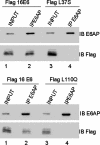Binding of human papillomavirus type 16 E6 to E6AP is not required for activation of hTERT
- PMID: 17942561
- PMCID: PMC2224393
- DOI: 10.1128/JVI.01776-07
Binding of human papillomavirus type 16 E6 to E6AP is not required for activation of hTERT
Abstract
The human papillomavirus (HPV) type 16 (HPV16) E6 protein stimulates transcription of the catalytic subunit of telomerase, hTERT, in epithelial cells. It has been reported that binding to the ubiquitin ligase E6AP is required for this E6 activity, with E6 directing E6AP to the hTERT promoter. We previously reported two E6AP binding-defective HPV16 E6 mutations that induced immortalization of human mammary epithelial cells. Because activation of hTERT is proposed to be necessary for epithelial cell immortalization, we sought to further characterize the relationship between E6/E6AP association and telomerase induction. We demonstrate that while these E6 mutants do not bind E6AP, they retain the capability to stimulate the expression of hTERT. Chromatin immunoprecipitation assays confirmed the presence of Myc, wild-type E6, and the E6AP binding-defective E6 mutants, but not E6AP itself, at the endogenous hTERT promoter. Interestingly, an immortalization-defective E6 mutant localized to the hTERT promoter but failed to increase transcription. We conclude that binding to E6AP is not necessary for E6 localization to or activation of the hTERT promoter and that another activity of E6 is involved in hTERT activation.
Figures





Similar articles
-
The E6AP ubiquitin ligase is required for transactivation of the hTERT promoter by the human papillomavirus E6 oncoprotein.J Biol Chem. 2005 Mar 18;280(11):10807-16. doi: 10.1074/jbc.M410343200. Epub 2005 Jan 17. J Biol Chem. 2005. PMID: 15655249
-
NFX1-123 and poly(A) binding proteins synergistically augment activation of telomerase in human papillomavirus type 16 E6-expressing cells.J Virol. 2007 Apr;81(8):3786-96. doi: 10.1128/JVI.02007-06. Epub 2007 Jan 31. J Virol. 2007. PMID: 17267499 Free PMC article.
-
HPV16-E6 associated hTERT promoter acetylation is E6AP dependent, increased in later passage cells and enhanced by loss of p300.Int J Cancer. 2006 Oct 15;119(8):1878-85. doi: 10.1002/ijc.22064. Int J Cancer. 2006. PMID: 16708385 Free PMC article.
-
Activation of telomerase by HPVs.Virus Res. 2017 Mar 2;231:50-55. doi: 10.1016/j.virusres.2016.11.003. Epub 2016 Nov 15. Virus Res. 2017. PMID: 27863966 Review.
-
Post-Transcriptional Gene Regulation by HPV 16E6 and Its Host Protein Partners.Viruses. 2022 Jul 6;14(7):1483. doi: 10.3390/v14071483. Viruses. 2022. PMID: 35891463 Free PMC article. Review.
Cited by
-
Enhanced Cytotoxic CD8 T Cell Priming Using Dendritic Cell-Expressing Human Papillomavirus-16 E6/E7-p16INK4 Fusion Protein with Sequenced Anti-Programmed Death-1.J Immunol. 2016 Mar 15;196(6):2870-8. doi: 10.4049/jimmunol.1502027. Epub 2016 Feb 5. J Immunol. 2016. PMID: 26851223 Free PMC article.
-
Cell-restricted immortalization by human papillomavirus correlates with telomerase activation and engagement of the hTERT promoter by Myc.J Virol. 2008 Dec;82(23):11568-76. doi: 10.1128/JVI.01318-08. Epub 2008 Sep 25. J Virol. 2008. PMID: 18818322 Free PMC article.
-
Structure based identification and characterization of flavonoids that disrupt human papillomavirus-16 E6 function.PLoS One. 2013 Dec 23;8(12):e84506. doi: 10.1371/journal.pone.0084506. eCollection 2013. PLoS One. 2013. PMID: 24376816 Free PMC article.
-
Genetic variations in human papillomavirus and cervical cancer outcomes.Int J Cancer. 2019 May 1;144(9):2206-2214. doi: 10.1002/ijc.32038. Epub 2019 Jan 4. Int J Cancer. 2019. PMID: 30515767 Free PMC article.
-
The ING4 Binding with p53 and Induced p53 Acetylation were Attenuated by Human Papillomavirus 16 E6.PLoS One. 2013 Aug 13;8(8):e71453. doi: 10.1371/journal.pone.0071453. eCollection 2013. PLoS One. 2013. PMID: 23967213 Free PMC article.
References
-
- Blackwood, E. M., and R. N. Eisenman. 1991. Max: a helix-loop-helix zipper protein that forms a sequence-specific DNA-binding complex with Myc. Science 2511211-1217. - PubMed
-
- Bodnar, A. G., M. Ouellette, M. Frolkis, S. E. Holt, C. P. Chiu, G. B. Morin, C. B. Harley, J. W. Shay, S. Lichtsteiner, and W. E. Wright. 1998. Extension of life-span by introduction of telomerase into normal human cells. Science 279349-352. - PubMed
Publication types
MeSH terms
Substances
Grants and funding
LinkOut - more resources
Full Text Sources

